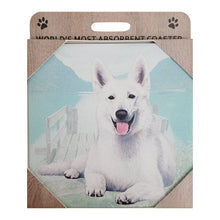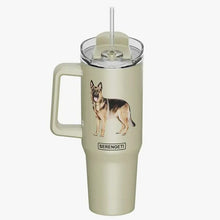4 Steps To Raise A Calm And Relaxed Dog

Teaching a dog to relax begins the first day you bring them into your home. It’s easier to teach puppies this skill but it can be taught to older dogs, as well as working breeds, notorious for their high energy levels.
One of the most important things you can do to raise a calm and relaxed dog is to be calm and relaxed yourself. Does this mean you can’t play or have fun? No, it simply means if you raise your pup in a predictable, stable environment, you will help them to be more calm and relaxed in their daily life.
1. Reduce Stress
Dogs are a product of their environment and will feed off the energy in a home. If you live in a stressful or unstable environment, it will be much harder or even impossible to teach a dog to be calm because other people in the home are not calm.
Chronic stress can cause dogs to be distressed, which may result in anxiety or other behavior problems. According to Jackie Maffucci, a PHD neuroscientist and animal behavior consultant, stress in the home can also increase a pet’s heart rate, blood pressure, and negatively affect their nervous system.
When dogs suffer from stress, they begin to focus on what is causing them stress. For this reason, it’s very important when training your dog to be calm and relaxed yourself. Dogs can actually regress in their training, begin urinating in the house, suffer a decrease in appetite, and exhibit other negative behaviors due to stress.
Stress in dogs can cause nervous behavior, anxiety, destructive chewing, and other behavior problems. Frustration with your dog or with other people in the house can cause anxiety and fear in pets, creating the exact opposite of a calm and relaxed dog-rather creating a nervous, anxious dog that doesn’t know what’s coming next.
By staying calm, positive, consistent, predictable in speech and behavior, kind, and loving, you create an environment that is less stressful and nurturing. Other things that can cause pets stress at home is a sudden change in routine, a new pet, a death in the family, illness of owner of the dog, house guests, new furniture, remodeling, changes in the neighborhood, construction, or a move. This type of stress is usually short lived and can be worked through by following the rest of the tips in this article and giving your dog extra support.
2. Stable Routine
By creating a stable routine for your pet, you help set them up for success, which instills calmness in them. If you can follow a regular schedule most of the time, your dog will quickly learn what is expected of them all the time.
For instance, if you feed your dog on a regular schedule, it makes bathroom breaks more predictable and easier. If you walk your dog on a regular schedule, their internal clock will usually tell them when it’s time for their walk. When they know what time you’ll be home from work, they’ll usually chill until you get there. When the dog knows they’ll get play time, they usually anticipate it and will be calmer while they wait for the magic hour to get there.
While in the real world it’s impossible to always stick to the same schedule, by following a schedule most of the time (very important with young puppies), your dog will be calmer because they know what to expect from you, and what you expect from them. Dogs excel when the activities of daily living are predictable.
3. Exercise and Play Time
Each dog is different but each dog needs the appropriate amount of exercise and play time. Just as you can’t fit a round peg into a square hole, you can’t mold a dog’s innate drive and personality into something it isn’t and won’t ever be.
You can help your dog to be calm and relaxed by knowing your breed and providing it with what it needs to be fulfilled and happy. If you have a French bulldog, your pup will need far less exercise than an active German shepherd. The same as with a young puppy that will need to burn off more steam than a senior couch potato.
A sad fact is, many dogs end up in shelters because they are brought into homes where their physical needs cannot be met. To prevent this, research the breed before buying. Or, now that you own the dog, take the time to provide them with enough exercise and unstructured play. If you can’t, ask or hire someone to help you.
A dog that doesn’t get enough exercise suffers from frustration and pent up energy, making it impossible for them to relax. You can’t expect a high energy dog to not burn of their high energy anymore than you can expect a lazy dog to run a marathon.
Each dog requires different amounts of energy for their breed, age, life stage, and health. For example, some little dogs get enough exercise just by playing indoors while other little dogs, such as a jack russell, need long sessions of physical exertion. Taking the time to exercise and play with your dog is a great bonding time and will improve all aspects of your relationship with your pet thus making them calmer and more relaxed.
4. Training
Another very important aspect of raising a calm and relaxed dog is training them. This seems like a basic concept but many frustrated owners find daily life getting in the way of training time. When this happens, dogs can soon run amuck, begin entertaining themselves, or start behaving in not so great of ways.
Training is important as it teaches the dog exactly what is expected of them, which instills a calm and relaxed mindset. Training also provides a dog with mental stimulation, and will burn up some of their physical energy.
Teaching your dog how to behave in the house, basic obedience skills, how to walk on a leash, how to act in public, etc. not only teaches them what is expected of them, it builds confidence and is just as important as their routine and exercise.
Important things to teach your pet that will help them be calm are to go to their place (a spot where they rest in the house), to be comfortable in a crate (a great skill in case of emergency, hospital stay, travel, or to keep them safe), and to control their impulses.
By providing your dog mental and physical stimulation during their training sessions, you teach them to relax and entertain themselves. For instance, when you train your dog to go to their place, if you give them a chew to keep them busy, they expend some energy focusing on their chew, which is also their reward. Hence, the place becomes something they look forward to.
In Conclusion:
All the steps in this article may seem basic but when taken together, they are important to the overall health and wellbeing of your dog. When your dog’s happy mentally and physically, and knows what is expected of them, they will be calmer and more relaxed.
They will also be more confident, better behaved, less anxious in new situations, when major changes occur, and can fit better into different environments, making it easier to take them on trips or to the vet.
Enriching your dog’s life with puzzles, treats, chew toys, new experiences, and new training skills will also help to keep them calm, better behaved, and turn them into well rounded pets that don’t get over stimulated over every new thing they see or smell.
We hope you found this information helpful. Please pass along to your family and friends.
























